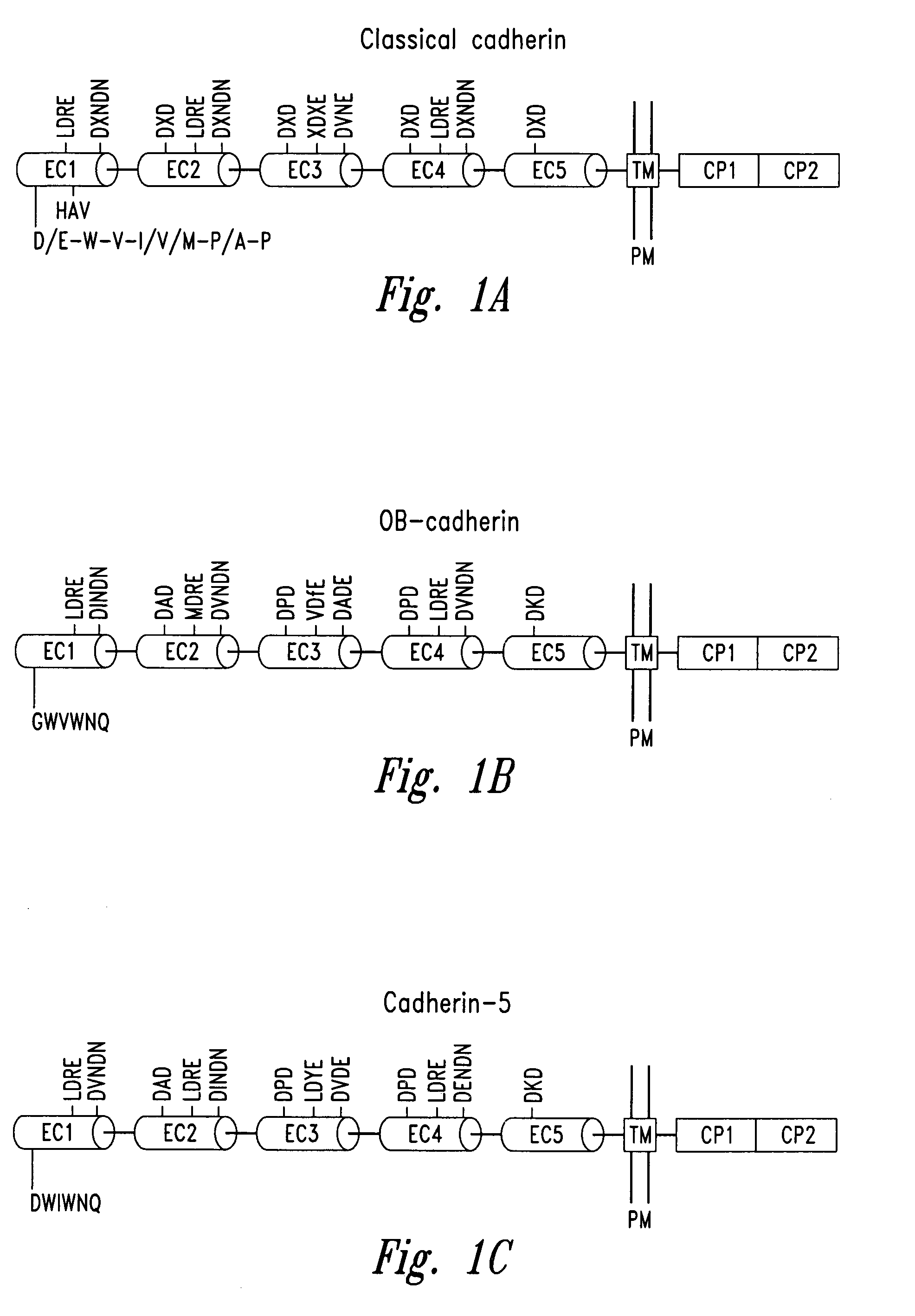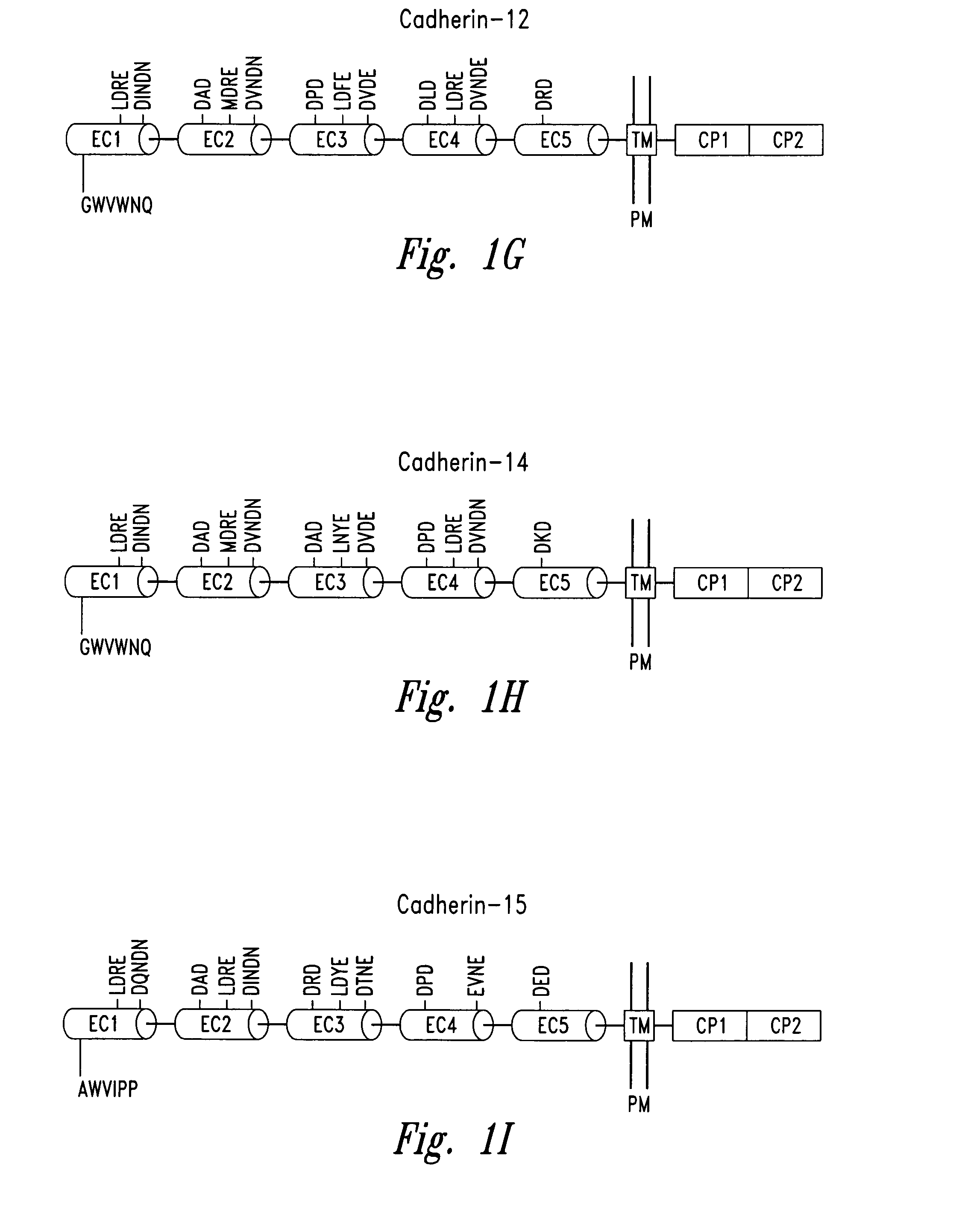Compounds and methods for modulating functions of nonclassical cadherins
a non-classical cadherin and function technology, applied in the direction of animal/human proteins, biocide, plant growth regulators, etc., can solve the problems that the function of non-classical cadherins remains poorly understood at the biological and molecular level, and achieve the effects of inhibiting endometriosis, enhancing inhaled compound delivery, and reducing endometriosis
- Summary
- Abstract
- Description
- Claims
- Application Information
AI Technical Summary
Benefits of technology
Problems solved by technology
Method used
Image
Examples
example 1
Preparation of Representative Cyclic Peptides
[0329]This Example illustrates the solid phase synthesis of representative cyclic peptides as cell adhesion modulating agents.
[0330]The peptides are assembled on methylbenzhydrylamine resin (MBHA resin) for the C-terminal amide peptides. The traditional Merrifield resins are used for any C-terminal acid peptides. Bags of a polypropylene mesh material are filled with the resin and soaked in dichloromethane. The resin packets are washed three times with 5% diisopropylethylamine in dichloromethane and then washed with dichloromethane. The packets are then sorted and placed into a Nalgene bottle containing a solution of the amino acid of interest in dichloromethane. An equal amount of diisopropylcarbodiimide (DIC) in dichloromethane is added to activate the coupling reaction. The bottle is shaken for one hour to ensure completion of the reaction. The reaction mixture is discarded and the packets washed with DMF. The N-α-Boc is removed by acid...
example 2
Disruption of Human Breast Cancer Cell Adhesion
[0332]This Example illustrates the detection of the ability of a candidate cell adhesion modulating agent to disrupt human breast epithelial cell adhesion.
[0333]MDA-MB-231 human breast cancer cells (Lombardi Cancer Research Center, Washington, D.C.) are used in these experiments. They express cadherin-11 (also known as OB-cadherin) but not N-cadherin or E-cadherin. The cells are plated (˜50,000 cells) on glass coverslips and cultured for 24 hours in DMEM containing 5% serum. A candidate cell adhesion modulating agent is dissolved in sterile water (the concentration may be, for example, 10 mg / ml), and 100 μl of the resulting stock solution is added to 1 ml of DMEM containing 5% serum. Control cells have 100 μl of water added to the medium. Cells are monitored by phase contrast microscopy. After 24 hours cells are fixed in formaldehyde. Water should have no effect on cell morphology; the cells treated with water remain flattened and well-...
example 3
Disruption of Endothelial Cell Adhesion
[0334]This Example illustrates the detection of the ability of a candidate cell adhesion modulating agent to disrupt endothelial cell adhesion.
[0335]Human umbilical vein endothelial cells are cultured using standard procedures (see Ichikawa et al., Amer. J. Physiol. 273 (Gastrointest. Liver Physiol. 36):3642-6347, 1997). Cells are maintained in EGM (Clonetics, San Diego, Calif.) and used at P2 for all experiments. Endothelial identity is established by Dil-LDL and factor VIII staining.
[0336]The cells are cultured on glass coverslips. Monolayers are exposed to a candidate cell adhesion modulating agent at a concentration of, for example, 75 μg / mL for 60 minutes. The cells are then fixed with 95% ethanol for 30 minutes at 4° C., followed by acetone for one minute and left to air dry at room temperature. Primary antibody for VE-cadherin (Immunotech, Marseilles, France; 1:250) is added for one hour at 37° C. Coverslips are then washed with 0.1% mil...
PUM
| Property | Measurement | Unit |
|---|---|---|
| size | aaaaa | aaaaa |
| adhesion | aaaaa | aaaaa |
| cell adhesion | aaaaa | aaaaa |
Abstract
Description
Claims
Application Information
 Login to View More
Login to View More - R&D
- Intellectual Property
- Life Sciences
- Materials
- Tech Scout
- Unparalleled Data Quality
- Higher Quality Content
- 60% Fewer Hallucinations
Browse by: Latest US Patents, China's latest patents, Technical Efficacy Thesaurus, Application Domain, Technology Topic, Popular Technical Reports.
© 2025 PatSnap. All rights reserved.Legal|Privacy policy|Modern Slavery Act Transparency Statement|Sitemap|About US| Contact US: help@patsnap.com



